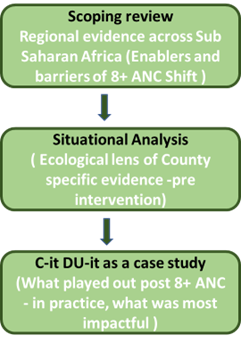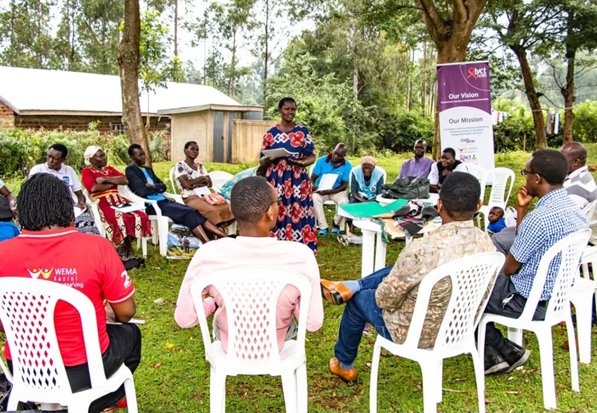
Rosemary Musuva, senior research officer at LVCT Health and third-year PhD candidate at LSTM whose doctoral research examines Kenya’s transition from four antenatal visits to the World Health Organization’s recommended eight and what it takes to make every antenatal visit count.

“It’s not just a numeric change,” she explains. “Many women struggle to make four antenatal care visits, and in 2016, recommendations shifted to eight. There is still a lot to learn about how we can support uptake and provision of this higher volume.” For Rosemary, this is as much a personal as it is an academic project. “This work resonates deeply with me, first as a woman of childbearing age in a developing country and secondly as a mother. Maternal and newborn health feels personal rather than abstract.”
Rosemary traces her interest in health research back to her early experiences in Kenya. After her undergraduate studies, she interned on a project working with informal settlements. “My observations in these settings generated questions about the social, structural, and systemic factors that influence health outcomes,” she recalls. These questions went on to shape her master’s work and, later, her PhD. Family was another strong influence. “I was fortunate to grow up surrounded by high achievers: my parents, siblings, uncles, and aunts, all of whom modelled ambition and perseverance. From an early age, their examples instilled in me the belief that there are no limits to what one can accomplish with dedication.”
From Questions to Methods: A Mixed-Methods Journey to Explore Health Factors
To find answers to her questions, Rosemary has chosen a mixed-methods approach, capturing both the big picture across Sub-Saharan Africa and the day-to-day realities of one Kenyan county. A scoping review gave her a high-level understanding of the challenges and enablers of shifting to eight visits in Sub-Saharan Africa. A situational analysis in Homa Bay County explored how policies, community norms, and health system factors might influence provision and uptake. And qualitative data from a realist evaluation showed what actually played out once the new model was introduced. “The scoping review provides the regional evidence, the situational analysis provides a county-specific perspective, and the realist evaluation shows what, in practice, was most impactful,” she explains. Her work also connects to the C-it Du-it intervention, which uses digital data linkage and quality improvement to support uptake of antenatal care, allowing her to test whether it addresses the key factors she has identified.

Local Ownership and Trusted Health Promoters Drive ANC Progress
This layered approach has already revealed some surprises. “Initially, the eight-visit antenatal care model was perceived primarily as a partner-driven program and a World Health Organization directive, with a limited sense of national ownership,” Rosemary says. But over time, Kenya has localized the model, and counties now design their own strategies to meet the targets.
Another shift concerns the role of community health promoters. At first, many stakeholders doubted their capacity to deliver even basic antenatal interventions. Yet, equipped with diagnostic tools and basic medicines, they have become trusted providers. “They are now widely embraced as the first level of care, often referred to as ‘level one’ providers or even informally regarded as local doctors,” Rosemary notes. To her, this reflects a wider truth: “The growing national and county ownership of the eight-contact model and the strengthened legitimacy of community health promoters have revealed resilience in sustaining and scaling antenatal care improvements, even amid shocks such as the withdrawal of donor funds or policy reforms.”
What makes Rosemary’s work distinctive is the way it connects evidence to experience. “Previous studies have often focused either on health system readiness or on individual-level barriers, but few have examined the full spectrum from community attitudes to national policies through a socioecological lens,” she explains. By combining reviews, qualitative studies, and policy analysis, she shows how community ownership, local NGOs, and digital innovations shape whether global recommendations become practical realities.
For Rosemary, the research is never just abstract. She sees it in the face of women like Achieng’, a young expectant mother in rural Homa Bay. At first, Achieng’ sees no reason to attend eight visits - her mother managed with four. But after a community health promoter visits her home, explains the benefits, and even accompanies her to the clinic, she begins to view each visit as a lifeline. It is also in the daily work of Mama Grace, a community health promoter who uses a mobile app to track women’s visits, record referrals, and patiently answer questions. And it is in the decisions of policymakers weighing limited budgets, whose choices ultimately decide whether models like the eight-contact approach succeed. Rosemary’s research places these stories side by side, reminding us that antenatal care is about people as much as policies.

Carrying Many Roles: Finding Balance in the Midst of a PhD
Like many PhD students, Rosemary’s path has not been without struggle. “The most trying moments come when I am juggling multiple responsibilities at work and at home. There are days the balance feels overwhelming, and I briefly question whether I can sustain the pace. What keeps me from quitting is the support from my supervisors, my research team, and my family.” One of her proudest moments came after months of doubt: “After tonnes of self-doubt, second guessing and getting over internal struggles, I sent out my very first manuscript draft.”
Outside of her academic work, Rosemary leans on music, food, and family for balance. She sings in a choir, where harmony and listening remind her of the value of working together. She enjoys experimenting in the kitchen to unwind after long days. Volunteering with charitable initiatives has also become a meaningful part of her life, giving her the chance to contribute to communities beyond her research. And above all, she treasures time with her young daughter, creating memories that ground her research in everyday life.
To aspiring PhD candidates, Rosemary offers gentle advice: “Stay open and flexible. Your first research question will almost certainly evolve, and that’s OK. Lean on mentors and peers who will both challenge and cheer you. Protect your well-being. Most importantly, hold close the ‘why’ that inspired you to begin and remember that bigger purpose will make every hurdle feel a little lighter and every small win feel significant.”
That bigger purpose guides her still: ensuring maternal health guidelines are not just adopted on paper but lived in practice. By showing what enables or constrains the shift to eight antenatal contacts, she is helping shape a future where fewer women and babies face preventable risks during pregnancy. In her words, it is also about honouring “the dedication of community health providers and amplifying women’s lived experience.”